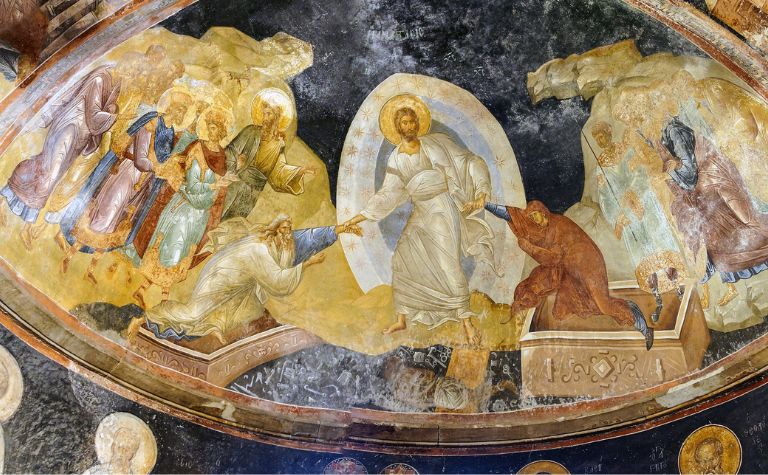Between Jesus’ resurrection and ascension, he appeared to hundreds of people, taught Scripture, and performed miracles. He also forgave Peter, helped Thomas to believe, and told the disciples to await the Holy Spirit’s imminent arrival. These events cause many Bible readers to wonder how long Jesus was on the earth after his resurrection.
According to Luke, the author of the book of Acts, Jesus was on the earth for 40 days after his resurrection from the dead. During that time, he spoke and appeared to people, including devout believers and hardened skeptics. The 40-day period was in the Spring between two annual festivals.
What New Testament books include stories from the 40 days? What did Jesus do for 40 days? Why 40 days instead of staying longer or shorter than that? What happened at the end of 40 days? What two festivals bracketed the period? Keep reading to learn the answers to these questions and others.
Also, see Why Did Jesus Come to Earth? to learn more.

The Days Between Jesus’ Resurrection and Ascension
Luke is the only writer in the New Testament that refers to the number of days that Jesus stayed on earth after his resurrection from the dead. However, all four Gospels and Acts include stories from the time. Paul also refers to the period in several of his letters (e.g., 1 Cor. 15:5-6).
The book of Acts is the second New Testament book that Luke wrote, the first being the Gospel that bears his name. Both books are addressed to Theophilus and concern “all that Jesus began to do and teach” (Acts 1:1). It’s in the introductory summary statement of the book that Luke mentions 40 days.
What did Jesus do for 40 days?
Luke refers to Jesus’ ascension as “the day when he was taken up, after he had given commands through the Holy Spirit to the apostles whom he had chosen” (Acts 1:2). Luke is more descriptive at the end of his Gospel: “While [Jesus] blessed them, he parted from them and was carried up into heaven” (Luke 24:51).
Next, Luke refers to the time between Jesus’ resurrection and ascension. “He presented himself alive to them after his suffering by many proofs, appearing to them during forty days and speaking about the kingdom of God” (Acts 1:3). There were 40 days between the resurrection and ascension.
- Jesus’ “suffering” refers to his crucifixion.
- “Presenting himself alive” refers to him appearing to hundreds of people after he rose from the dead. (cf. 1 Cor. 15:5-6)
- “Proofs” likely refers to Jesus’ appearances, miracles (e.g., John 21:4-8), and the conversations he had with people, like when he told Thomas to touch the holes in his hands (John 20:24-29).
- He also taught people Scripture (cf. Luke 24:45), especially on the topic of the kingdom of God.
Also, see Where Was Joseph When Jesus Died? to learn more.

What is the significance of 40 days?
The number 40 appears several times in the Bible, yet its significance often relates to years, not days. For example, Israel wandered in the desert for 40 years after leaving Egypt (Num. 14:34). However, scholars also tend to view the period of 40 days as literal, not symbolic.
For example, in the story of Noah and the flood, the waters on the earth arose for 40 days (Gen. 7:17). Also, when Jonah finally got to Ninevah, he announced that judgment would occur in 40 days (Jon. 3:4). Jesus also fasted for 40 days before Satan tempted him (Matt. 4:1-11).
Acts scholar Darrell Bock writes, “There is no OT symbolic/figurative sense for forty days; forty years in the wilderness or as the length of a king’s reign is perhaps the closest type. This divergence from the common use of the number makes it quite likely that this is a specific period of time, and so the number is literal in force even if it might convey something more.” [1]
Why 40 days?
Why didn’t Jesus stay on the earth for one week or one year? Why 40 days? The Bible doesn’t explicitly say why Jesus ministered for 40 days before his ascension. However, it’s clear from the Gospels and Acts that his work was important, and God determined, in his sovereignty, that 40 days was sufficient.
Some commentators suggest that 40 was required for Jesus to demonstrate convincing “proofs” (Acts 1:3). For example, New Testament scholar F.F. Bruce writes, “Over a period of forty days between his resurrection and ascension Jesus appeared at intervals to his apostles and other followers in a manner which could leave no doubt in their minds that he was really alive again, risen from the dead.” [2]
The Holy Spirit’s arrival
Jesus also needed to depart so the Holy Spirit could arrive and be present in a special way. He previously told the disciples that the Spirit would come and teach them (John 15:26). The Spirit’s arrival at Pentecost fulfilled Jesus’ promise.
Jesus’ last words before his ascension also refer to the Spirit’s arrival: “You will receive power when the Holy Spirit has come upon you, and you will be my witnesses in Jerusalem and in all Judea and Samaria, and to the end of the earth” (Acts 1:9, ESV).
About ten days later, the Holy Spirit arrived in a special way a few days later on Pentecost (Acts 2:1-13).
Also, see Why Did Jesus Descend Into Hell? to learn more.

After the Resurrection: From Passover to Pentecost
The time between Jesus’ resurrection and ascension occurred between Passover and Pentecost. There are 50 days between these festivals; however, Jesus was only on the earth for 40 of them.
Jesus died during Passover
Jesus was crucified in Jerusalem during Passover (e.g., John 19:14) and rose from the dead three days later. The annual Passover festival recalled God freeing Israel from slavery in Egypt. Thousands of people visited Jerusalem in the first century to observe the festival.
The commemoration occurred on the 14th day of the 1st month (Lev. 23:5). In the Gospels and elsewhere in the New Testament (e.g., 1 Cor. 5:7), Jesus is considered the Passover lamb.
Jesus ascended before Pentecost
Traditionally called the “Feast of Weeks,” Israelites celebrated Pentecost seven weeks or 50 days after Passover (Lev. 23:15-16). The prefix “pente” in Greek means “five,” hence the name.
Acts 2:1 mentions this festival: “When the day of Pentecost arrived, they were all together in one place” (ESV). Yet, Luke reports that Jesus ascended before that: “And when he had said these things, as they were looking on, he was lifted up, and a cloud took him out of their sight” (Acts 1:9).
Also, see How Many People Did Jesus Feed? to learn more.
References:
[1] Acts by Darrell Bock. BECNT. p. 55.
[2] The Book of Acts by F.F. Bruce. NICNT. p. 31.
Related Questions
There are 66 individual books in the Bible. There are 39 in the Old Testament and 27 in the New Testament. Many readers can read the shortest books in the Bible in 5 to 10 minutes. The longest book...
Catholic vs. Protestant vs. Orthodox: What's the Difference?
Roman Catholicism, Protestant Christianity, and the Eastern Orthodox Church are the three historical branches of the Christian religion. Each tradition traces its doctrines and practices to the New...
